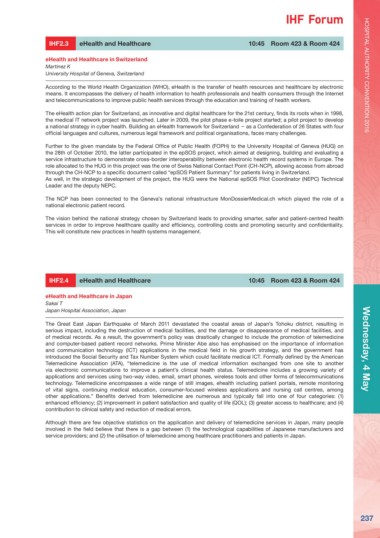Page 239 - HA Convention 2016 [Full Version]
P. 239
IHF Forum HOSPITAL AUTHORITY CONVENTION 2016
IHF2.3 eHealth and Healthcare 10:45 Room 423 & Room 424
eHealth and Healthcare in Switzerland
Martinez K
University Hospital of Geneva, Switzerland
According to the World Health Organization (WHO), eHealth is the transfer of health resources and healthcare by electronic
means. It encompasses the delivery of health information to health professionals and health consumers through the Internet
and telecommunications to improve public health services through the education and training of health workers.
The eHealth action plan for Switzerland, as innovative and digital healthcare for the 21st century, finds its roots when in 1998,
the medical IT network project was launched. Later in 2009, the pilot phase e-toile project started; a pilot project to develop
a national strategy in cyber health. Building an eHealth framework for Switzerland – as a Confederation of 26 States with four
official languages and cultures, numerous legal framework and political organisations, faces many challenges.
Further to the given mandate by the Federal Office of Public Health (FOPH) to the University Hospital of Geneva (HUG) on
the 28th of October 2010, the latter participated in the epSOS project, which aimed at designing, building and evaluating a
service infrastructure to demonstrate cross-border interoperability between electronic health record systems in Europe. The
role allocated to the HUG in this project was the one of Swiss National Contact Point (CH-NCP), allowing access from abroad
through the CH-NCP to a specific document called “epSOS Patient Summary” for patients living in Switzerland.
As well, in the strategic development of the project, the HUG were the National epSOS Pilot Coordinator (NEPC) Technical
Leader and the deputy NEPC.
The NCP has been connected to the Geneva’s national infrastructure MonDossierMedical.ch which played the role of a
national electronic patient record.
The vision behind the national strategy chosen by Switzerland leads to providing smarter, safer and patient-centred health
services in order to improve healthcare quality and efficiency, controlling costs and promoting security and confidentiality.
This will constitute new practices in health systems management.
IHF2.4 eHealth and Healthcare 10:45 Room 423 & Room 424
eHealth and Healthcare in Japan Wednesday, 4 May
Sakai T
Japan Hospital Association, Japan
The Great East Japan Earthquake of March 2011 devastated the coastal areas of Japan’s Tohoku district, resulting in
serious impact, including the destruction of medical facilities, and the damage or disappearance of medical facilities, and
of medical records. As a result, the government’s policy was drastically changed to include the promotion of telemedicine
and computer-based patient record networks. Prime Minister Abe also has emphasised on the importance of information
and communication technology (ICT) applications in the medical field in his growth strategy, and the government has
introduced the Social Security and Tax Number System which could facilitate medical ICT. Formally defined by the American
Telemedicine Association (ATA), “telemedicine is the use of medical information exchanged from one site to another
via electronic communications to improve a patient’s clinical health status. Telemedicine includes a growing variety of
applications and services using two-way video, email, smart phones, wireless tools and other forms of telecommunications
technology. Telemedicine encompasses a wide range of still images, ehealth including patient portals, remote monitoring
of vital signs, continuing medical education, consumer-focused wireless applications and nursing call centres, among
other applications.” Benefits derived from telemedicine are numerous and typically fall into one of four categories: (1)
enhanced efficiency; (2) improvement in patient satisfaction and quality of life (QOL); (3) greater access to healthcare; and (4)
contribution to clinical safety and reduction of medical errors.
Although there are few objective statistics on the application and delivery of telemedicine services in Japan, many people
involved in the field believe that there is a gap between (1) the technological capabilities of Japanese manufacturers and
service providers; and (2) the utilisation of telemedicine among healthcare practitioners and patients in Japan.
237

